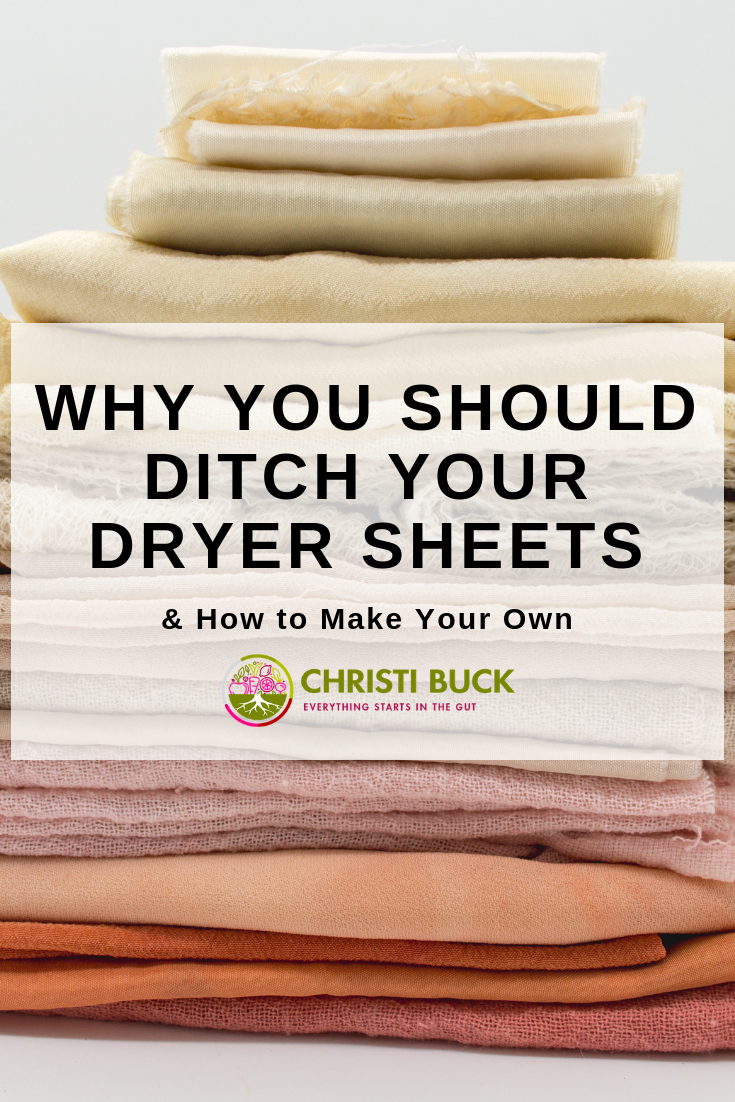You might have grown up in a home that uses dryer sheets. Don’t worry – we almost all did! It sounds like a good idea, right? Who wouldn’t want their clothes to come out of the laundry soft, static-free, and smelling wonderful? Wrong. Fabric softeners and dryer sheets are loaded with chemicals that can harm your health and the environment.
1. Quaternary Ammonium Compounds
That sounds scary, right? Well it should. Quaternary ammonium compounds are widely used as surface disinfectants in antibacterial wipes, but they also find their way into dryer sheets and fabric softeners!
The most common softening chemicals are called “quats” (short for quaternary ammonium compounds) and include such chemical mouthfuls as diethyl ester dimethyl ammonium chloride, dialkyl dimethyl ammonium methyl sulfate, dihydrogenated palmoylethyl hydroxyethylmonium methosulfate and di-(palm carboxyethyl) hydroxyethyl methyl ammonium methyl sulfate.
“Quats” should be particularly concerning to you if you or your children have asthma. Studies show that exposure to quats can increase the risk of developing asthma. Another downside to exposing yourself to quats in the name of having softer clothes? They might could encourage antibiotic resistance.
2. Fragrances
At first glance, fragrances sound harmless. But did you know that companies can put any chemical into a product’s “fragrance” without listing it as an ingredient?
When you see “fragrance” on a personal care product’s label, read it as “hidden chemicals.” A major loophole in FDA’s federal law lets manufacturers of products like shampoo, lotion, and body wash include nearly any ingredient in their products under the name “fragrance” without actually listing the chemical.
This study found that 30.5% of the general population reported scented products on others irritating, 19% reported adverse health effects from air fresheners, and 10.9% reported irritation by scented laundry products vented outside. Long story short, a considerable percentage of the population reports adverse health effects or irritation from fragranced products. The same study reports higher percentages among those with asthma and chemical sensitivity.
3. Preservatives & Other Chemicals
Like fragrance, the term “preservatives” on a product’s ingredient label can be hiding any number of chemicals. According to the EWG, the most worrisome preservatives in fabric softeners include:
- methylisothiazolinone – associated with skin irritation/allergies/damage
- glutaral – associated with skin irritation/allergies/damage and general systemic/organ effects
You’re likely to find some, if not all, of these other chemicals in your dryer sheets:
- alpha terpineol
- benzyl acetate
- camphor
- dichlorobenzene
- ethanol
- limonene
- pentane
And that’s just to name a few!
4. Protect the Environment
This one seems simple and obvious, but it’s easy to forget! Typically, dryer sheets are made of thin polyester which isn’t recyclable. Even if you use dryer sheets from unbleached paper, they typically contain essential oil. While this will help your clothes smell great, the oils will contaminate the paper recycling.
Alternatives to Traditional Dryer Sheets
Does this mean you’ll have unsoft clothes forever? Nope. There are tons of alternatives to dryer sheets and fabric softeners!
- Add a 1/2 cup of distilled white vinegar to your washing machine during the rinse cycle.
- Sprinkle ¼ cup of baking soda into the washer during the main wash cycle.
- Use 100% wool dryer balls. These should soften laundry, reduce static. and lift and separate clothes in the dryer.
- DIY dryer sheets – see below!
![]()
You can also simply skip the alternatives (you probably won’t even miss them) and simply dry your clothes all by themselves. Pro tip: don’t over-dry your clothes! Overdrying leads to extra static. And if you’re not ready to part with them quite yet, here’s a list of fabric softeners ranked based on their toxicity levels from the EWG.
- ½ cup white vinegar
- 5-10 drops of from your favorite essential oil
- Sealable, glass container
- Cotton fabric scraps
- Cut your fabric scraps into squares. Any shape will do, but think of the size of an index card!
- Pour the vinegar and essential oils into the glass container and shake it up.
- Add your fabric scraps to the glass container and allow them to absorb the mixture.
- When it comes time to put your clothes in the dryer, take a homemade dryer sheet out of the container, remove the excess liquid and throw it with your load.
- Once your load is dry, retrieve the reusable dryer sheet and place it in the glass container


